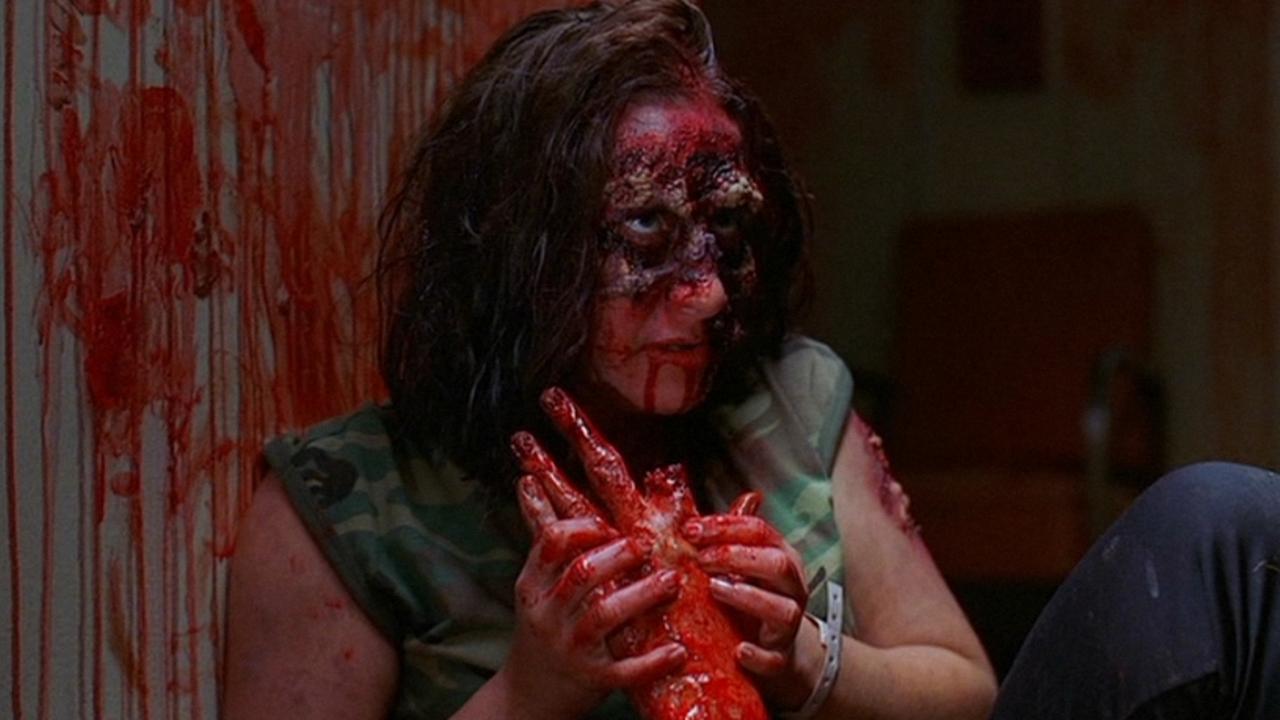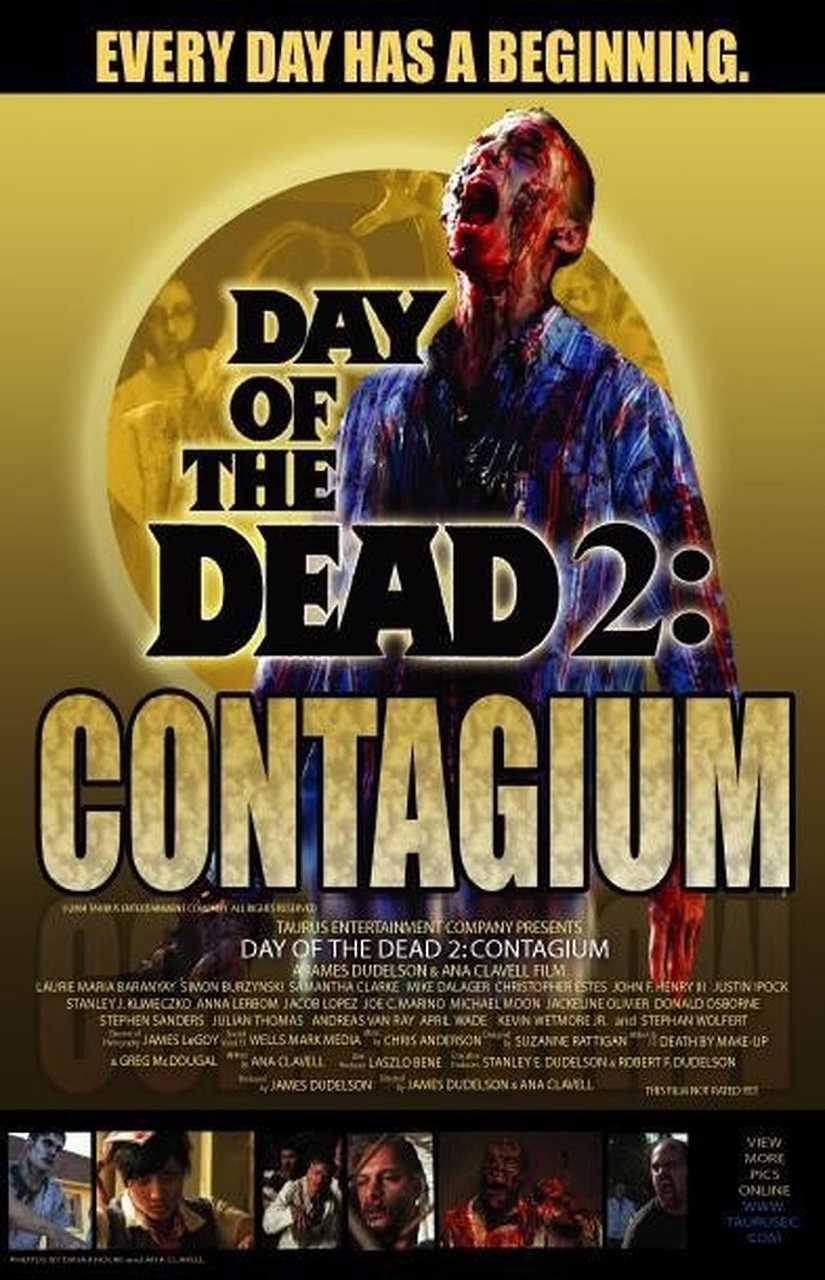USA. 2005.
Crew
Directors – Ana Clavell & James Dudelson, Screenplay – Ana Clavell, Producer – James Dudelson, Photography – James LeGoy, Music – Chris Anderson, Visual Effects Supervisor – Geoffrey Mark, Visual Effects – Wells/Mark Media, Inc., Makeup – Kelly Amber O’Leary, Makeup Effects – Greg McDougall, Production Design – Suzanne Rattigan. Production Company – Taurus Entertainment Company/Suraut Corporation.
Cast
Stephan Wolfert (Dr Donwynn), Justin Ipock (Isaac), Laurie Maria Baranyay (Emma), Julian Thomas (Sam), John F. Henry III (Jackie), Steve Colosi (Boris), April Wade (Patty), Jackeline Olivier (Vicky), Samantha Clarke (Ava Flores), Andreas van Ray (Dr Heller), Joe C. Marino (Marshall), Kevin Wetmore Jr (Jerry DeLuca), Simon Burzynski (Rudinsky), Michael Moon (DeLuca)
Plot
In 1968, soldiers arrive at the Ravenside Military Hospital in Pennsylvania and begin shooting the people inside en masse. A man escapes carrying a flask but is shot as he tries to flee. In the present day, a psychiatric hospital has been built on the site. The progressive psychologist Donwynn is out in the grounds with several patients when one of them finds the flask fallen in a hollow. Back inside the hospital, one patient opens the flask, which releases glowing lights that touch Donwynn and the five patients present. Soon after, the group find that all of them can feel the others’ pain as well as share their thoughts but that they are now medically dead. They realize that they have been infected with a virus that is transforming them into something more than human. However, the transformation also serves to make them hungry for human flesh. Those that they infect with their bite turn into zombies. As the doctors place the hospital under quarantine, it is soon overrun with ravening, flesh-hungry zombies.
The last few years have seen a major revival of interest in the zombie films of George A. Romero, which consist of Night of the Living Dead (1968), Dawn of the Dead (1978) and Day of the Dead (1985). We have seen a number of films that owe a substantial debt of inspiration to Romero – Resident Evil (2002), 28 Days Later (2002), House of the Dead (2003), Dead Meat (2004), Zombie Honeymoon (2004), Zombie Nation (2004), All Souls Day (2005), Boy Eats Girl (2005), Dead Life (2005), Dead Men Walking (2005), Hood of the Living Dead (2005), Raiders of the Damned (2005), Zombiez (2005), Automaton Transfusion (2006), Deadlands: The Rising (2006), Dorm of the Dead (2006), Night of the Dead “Leben Tod” (2006), The Quick and the Undead (2006), Wicked Little Things (2006), Zombie Wars (2006), Awaken the Dead (2007), Dead Moon Rising (2007), Rising Dead (2007), Undead or Alive (2007), Zombie Farm (2007), Carnival of the Damned (2008), Colin (2008), Dance of the Dead (2008), Dead Country (2008), Dead Set (tv mini-series, 2008), Make-Out With Violence (2008), Mutant Vampire Zombies from the ‘Hood (2008), Ninjas vs Zombies (2008), Otto; or, Up With Dead People (2008), Pontypool (2008), Reel Zombies (2008), Risen (2008), Against the Dark (2009), Autumn (2009), Dead Snow (2009), The Dead Undead (2009), Edges of Darkness (2009), The Horde (2009), Horrid (2009), Platoon of the Dead (2009), Silent Night, Zombie Night (2009), Yesterday (2009), Zombieland (2009), Zone of the Dead (2009), The Dark Lurking (2010), The Dead (2010), The Dead and the Damned (2010), the tv series The Walking Dead (2010-22), Zombie Apocalypse (2010), Zombie Beach (2010), Bloodlust Zombies (2011), Exit Humanity (2011), Xombies 3D (2011), The Battery (2012), World War Z (2013), Wyrmwood: Road of the Dead (2014) and Navy Seals vs Zombies (2015); outright remakes – Dawn of the Dead (2004), Night of the Living Dead 3D (2006) and Day of the Dead (2008); parodies and comedy takes – Zombie Beach Party (2003), Shaun of the Dead (2004), Fido (2006), Planet Terror (2007), Zombie Cheerleader Camp (2007), Zombie Strippers! (2008), Attack of the Vegan Zombies! (2009), Doghouse (2009), George’s Intervention (2009), Romeo and Juliet vs the Living Dead (2009), Stag Night of the Dead (2009), Zombies of Mass Destruction (2009), Big Tits Zombie (2010), Dale of the Dead (2010), L.A. Zombie (2010), Santa Claus vs. the Zombies (2010), Zombie Driftwood (2010), Zombie Drugs (2010), Bong of the Dead (2011), Deadheads (2011), Juan of the Dead (2011), Abraham Lincoln vs. Zombies (2012), Cockneys vs Zombies (2012), Pro Wrestlers vs Zombies (2014), Zombeavers (2014), MILFs vs Zombies (2015), Scouts Guide to the Zombie Apocalypse (2015), Attack of the Lederhosen Zombies (2016), Pride and Prejudice and Zombies (2016) and Fat Ass Zombies (2020), A Little Bit Zombie (2012) and Warm Bodies (2013); Romero’s own follow-ups – Land of the Dead (2005), Diary of the Dead (2007) and Survival of the Dead (2009); and other spinoffs such as Return of the Living Dead: Necropolis (2005), Return of the Living Dead: Rave to the Grave (2005), the animated anthology Night of the Living Dead Reanimated (2009) and Night of the Living Dead: Darkest Dawn (2015).
Like the Return of the Living Dead sequels, Day of the Dead 2: Contagium might be regarded as a distaff clinger-on to the Romero name. Contagium poses as a sequel to Day of the Dead, Romero’s third film in the series. Day of the Dead was a superbly underrated film – it gave a thinking and bleakly sociological perspective to the zombie splatter of Dawn of the Dead, although was the least financially successful of Romero’s Dead films. The dvd cover for Day of the Dead 2: Contagium pretentiously claims to be both a prequel and a sequel to Day of the Dead.
If anything though, Day of the Dead 2: Contagium feels like it could easily be construed as both a prequel and sequel to Night of the Living Dead, to which it bears much more in common. It is however a hard stretch of the imagination to see Contagium as a sequel to Day of the Dead. In Day of the Dead, the zombies had entirely overrun the Earth – here it seems well before that point, indeed Contagium concerns itself with the origin of the zombie outbreak. More than anything, it feels like the filmmakers wanted to sequelize Night of the Living Dead but were unable to get the rights so settled for calling Contagium a sequel to Day of the Dead. Elsewhere the plot points about the canister of military toxin creating the zombies and people realising they are medically dead brings Day of the Dead 2: Contagium closer to Return of the Living Dead (1985), another black sheep cousin to the Romero films.
Day of the Dead 2: Contagium was greeted with a series of scathing reviews, which called it, among other things, the worst hanger-on ever to the Romero name. (Although, the film that more appropriately deserves that privilege is Return of the Living Dead Part II (1988). For the most part, one ends up concurring. The opening scenes in 1968 are cheaply shot and tedious, the photography and editing often seem at the level of an amateur film.

The modern day scenes certainly offer a novel and original setting – a zombie film set in a psychiatric institution – but the directorial set-ups and handling of actors seems utterly crude. When the film gets to scenes of mysterious lights coming out of the canister and touching everybody’s foreheads, Contagium has such a cheesy 1980s bad science-fiction movie silliness that it could not seem further from a gore-drenched Romero zombie film if it tried. Going by these scenes, one is certain that did Contagium not have the association with the Romero name, it would never have gotten any kind of major release on its own terms.
For the most part, Day of the Dead 2: Contagium has little of the trademark Romero gore scenes – just numerous cheap bullet hole effects that are repetitive and certainly nowhere near the quality that Tom Savini established on Dawn and the original Day of the Dead. One good scene is where Joe C. Marino has his entire head progressively turned into a mash of bloody pulp like a split-open watermelon and then grabs a patient through the window of the door and returns the body gorily severed at the neck.
During the latter half of the film when the hospital starts to be infected, Contagium finally does give us all that we expect of a Romero film and washes the walls with blood and numerous scenes of zombies devouring intestines, gnawing on limbs etc. Here at least, Contagium gives us some of the real stuff, rather than waters it down and wimps out like some of the other Romero copies – Resident Evil, 28 Days Later and Dawn of the Dead 04.
Eventually, at least in its second half, you do have to give Day of the Dead 2: Contagium full marks for conceptual ingenuity. It expands out and offers an explanation of the background leading up to Night of the Living Dead – that the dead were brought back to life by a virus that came in from Russia, that the virus needs people to devour one another in order to spread itself and that it takes full control of the body’s autonomic responses in order to keep its dead subjects moving, as well as adding fascinating ideas about an elite of core infectees who are transforming into something more than human. It is certainly one of the more conceptually ingenious of the Dead films and follow-ups even if the directorial execution is amateurish.
Co-directors/writers/producers Ana Clavell and James Dudelson had previously made a number of other low-budget horror films, including an sf version of Edgar Allan Poe’s Morella (1997), Horror 101 (2000), Horror 102: Endgame (2004) and Museum of the Dead (2004). The two conducted a further Romero follow-up with Creepshow III (2006), while Dudelson also produced the Day of the Dead remake and Day of the Dead: Bloodline (2018).
Trailer here


